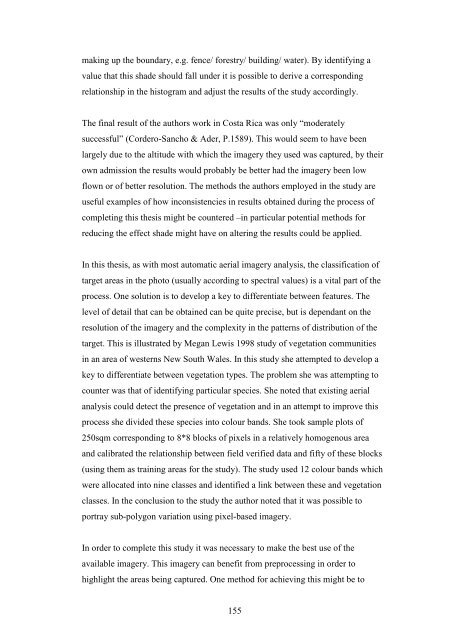You also want an ePaper? Increase the reach of your titles
YUMPU automatically turns print PDFs into web optimized ePapers that Google loves.
making up the boundary, e.g. fence/ forestry/ building/ water). By identifying a<br />
value that this shade should fall under it is possible to derive a corresponding<br />
relationship in the histogram and adjust the results of the study accordingly.<br />
The final result of the authors work in Costa Rica was only “moderately<br />
successful” (Cordero-Sancho & Ader, P.1589). This would seem to have been<br />
largely due to the altitude with which the imagery they used was captured, by their<br />
own admission the results would probably be better had the imagery been low<br />
flown or of better resolution. The methods the authors employed in the study are<br />
useful examples of how inconsistencies in results obtained during the process of<br />
completing this thesis might be countered –in particular potential methods for<br />
reducing the effect shade might have on altering the results could be applied.<br />
In this thesis, as with most automatic aerial imagery analysis, the classification of<br />
target areas in the photo (usually according to spectral values) is a vital part of the<br />
process. One solution is to develop a key to differentiate between features. The<br />
level of detail that can be obtained can be quite precise, but is dependant on the<br />
resolution of the imagery and the complexity in the patterns of distribution of the<br />
target. This is illustrated by Megan Lewis 1998 study of vegetation communities<br />
in an area of westerns New South Wales. In this study she attempted to develop a<br />
key to differentiate between vegetation types. The problem she was attempting to<br />
counter was that of identifying particular species. She noted that existing aerial<br />
analysis could detect the presence of vegetation and in an attempt to improve this<br />
process she divided these species into colour bands. She took sample plots of<br />
250sqm corresponding to 8*8 blocks of pixels in a relatively homogenous area<br />
and calibrated the relationship between field verified data and fifty of these blocks<br />
(using them as training areas for the study). The study used 12 colour bands which<br />
were allocated into nine classes and identified a link between these and vegetation<br />
classes. In the conclusion to the study the author noted that it was possible to<br />
portray sub-polygon variation using pixel-based imagery.<br />
In order to complete this study it was necessary to make the best use of the<br />
available imagery. This imagery can benefit from preprocessing in order to<br />
highlight the areas being captured. One method for achieving this might be to<br />
155
















